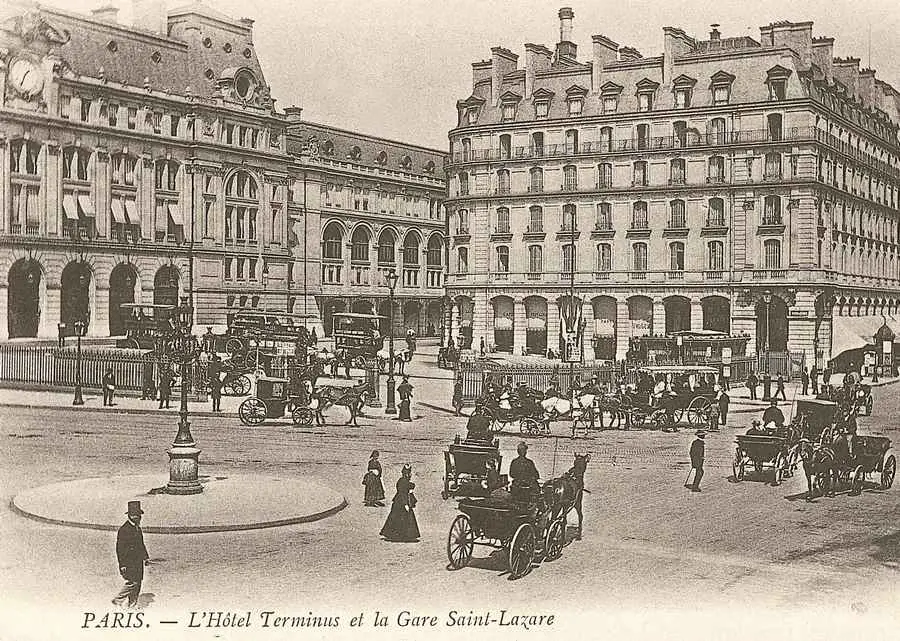Paris Saint-Lazare, Train Station Building France, French Railway Architecture
Gare Saint-Lazare : Paris Train Station
Parisian Railway Building, France – design by AREP, architects
23 Jul 2012
Gare Saint-Lazare Paris
Design: AREP Architects
Saint-Lazare Train Station Building
Architects: J-.M. Duthilleul et F. Bonnefille, E. Tricaud (SNCF/AREP), P. Gorce et T. de Dinechin (DGLa)
Location: Franche-Comté région, north-east France
L’hôtel Terminus et la gare Saint Lazare vers 1900, carte postale ancienne Architecte : J. Lisch
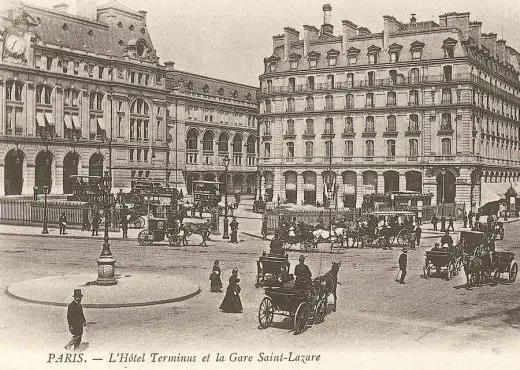
photos © SNCF- AREP
Gare Saint-Lazare – Brief History
From the opening of the station in 1837 to its transformation in 2012.
Saint-Lazare is the oldest railway station in France. It opened in 1837, two years after the first railway line came into service – the Paris Saint-Germain line carrying travellers west as far as Le Pecq. The first passenger shed was located between the Place de l’Europe and the Rue de Stockholm.
The station gradually expanded with the addition of disparate buildings in the area bounded by the Rue d’Amsterdam and the Rue de Rome, including a second passenger shed (at the corner of Rue Saint-Lazare and Rue d’Amsterdam) built in 1841. Rail traffic increased considerably when new lines to Rouen and Le Havre were opened in 1843, and the station further expanded, with the tracks extended towards the Rue Saint- Lazare.
Les voies de la gare Saint Lazare en 1909
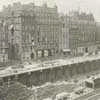
photos © SNCF- AREP
A monumental station building with classical façades, the work of architect Alfred Armand and engineer Eugène Flachat, was erected between 1842 and 1853. The platforms were covered with a glass canopy and the different buildings were linked by a glass-roofed gallery. The main concourse was now one large area linking all the platforms, a communication space between the waiting hall and the platforms. In 1885 the various components of the old station were brought together in a single building, designed by architect Juste Lisch, and the Cour de Rome and Cour du Havre were linked. In 1889 the company operating both the station and the lines – the Compagnie des Chemins de Fer de l’Ouest – erected the Hôtel Terminus. Also designed by Juste Lisch, it was built to accommodate visitors to the Exposition Universelle who had sailed from New York and disembarked at Le Havre or Cherbourg.
Paris Saint-Lazare, cour du Havre en 1919, carte postale ancienne Architecte : J. Lisch
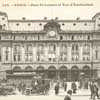
photos : SNCF – AREP
Paris Saint-Lazare, travaux coeur de gare – Début des démolitions dans la galerie de Versailles (déc. 2009)
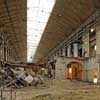
photo : SNCF – AREP / Photographe M. Vigneau
The station underwent considerable development during the 20th century. The arrival of the metro in 1905 meant that openings had to be made in the façade and staircases built. A shopping arcade was created in 1935, providing travellers with a range of services and stores. Escalators were installed in 1972, and an underpass was opened under the platforms in 1980. There was no further modernization. Following an initial listing in 1979, the station was fully protected as a Historical Monument in 1984. The protection covers the station’s façades and roofs, waiting hall, and main concourse. It also covers the façades and roofs of the Hôtel Concorde- Opéra (the former Hôtel Terminus), and the interior decoration of its lobby.
Paris Saint-Lazare, travaux coeur de gare – Début de l’excavation du sous-sol (sept. 2010)

photo : SNCF – AREP / M. Vigneau
Gare Saint-Lazare Renewal – Programme Context
Saint-Lazare station is located in the Haussmann- Opéra sector of the 8th arrondissement, the city’s main shopping and business district. A major commuter station, it occupies a total area of 30,000 square metres, including 10,000 square metres for the passenger building.
Saint-Lazare is the second busiest station in Paris, after the Gare du Nord, with 450,000 users a day (16% of whom are not travellers). In terms of rail passengers, it is the second busiest station in Europe, with 100 million travellers a year.
Gare Saint-Lazare, les commerces de la galerie (mars 2012)
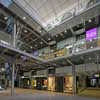
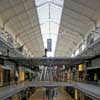
photos : SNCF – AREP / M. Vigneau
The station is served by 27 lines carrying around 1,600 trains a day.
The Haussmann-Opéra-Saint-Lazare quarter is also the biggest intermodal hub in Paris, served by two rapid-transit RER lines (A and E), six metro lines, and 27 bus routes. The old shopping arcade under the waiting hall, at forecourt/street level, comprised around fifty stores covering some 6,000 square metres.
Gare de Paris Saint-Lazare en cours d’achèvement de réamènagement (mars 2012)
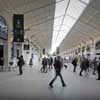
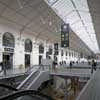
photos : SNCF – AREP / M. Vigneau
Over the years, however, the station became increasingly ill-equipped to handle passenger flow. Frequently congested, it no longer met acceptable standards for clarity, accessibility and functionality.
These shortcomings applied both to the station itself and to connections with other means of transport. To reach the metro, travellers passed through a bottleneck and followed walkways that were both confusing and congested.
Gare de Paris Saint-Lazare en cours d’achèvement de réamènagement (mars 2012)
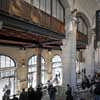
photos : SNCF – AREP / M. Vigneau
Gare Saint-Lazare Renewal – 1996 Partnership
To remedy this situation, in 1996 SNCF launched a consultation process under the title “Demain Saint-Lazare”. Developers and architects were invited to submit tenders for the renovation and restructuring of the station and the provision of shopping areas, according to a plan finalized by SNCF’s Stations Agency and AREP (architects Jean-Marie Duthilleul, Étienne Tricaud, François Bonnefille and Jean-Louis Salama).
Gare de Paris Saint-Lazare de nuit, en cours d’achèvement de réamènagement – La salle des pas perdus (mars 2012)
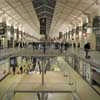
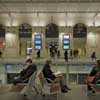
photos : SNCF – AREP / M. Vigneau
The contract was awarded to a consortium comprising developer Spie Batignolles Immobilier and investor Klépierre (with its subsidiary Ségécé, specialists in shopping centres), and the DGLa agency (associates Thierry de Dinechin and Philippe Gorce) linked to SNCF by a 40-year operating contract.
Gare de Paris Saint-Lazare de nuit, en cours d’achèvement de réamènagement – L’escalier monumental (mars 2012)
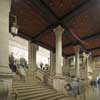
photo : SNCF – AREP / M. Vigneau
The successful agencies worked according to the terms of the competition in association with SNCF and its project managers, SNCF’s Stations Agency and AREP (Jean-Marie Duthilleul, Étienne Tricaud, François Bonnefille), and managed joint teams in shared premises. This partnership between a specialist in stations and a specialist in shopping centres capitalized on each party’s expertise and ensured the success of the programme.
Gare de Paris Saint-Lazare de nuit, en cours d’achèvement de réamènagement – L’escalier (mars 2012)
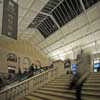
photo : SNCF – AREP / M. Vigneau
Gare Saint-Lazare – Main Principles
The architects for “Demain Saint-Lazare” developed their project according to four guiding principles: “reveal” the building by highlighting the original architecture, link the station’s three main levels (metro, street, trains) via one sole atrium, take natural light all the way down to the metro below street level, and unify the different public areas. The various components – lighting, materials (stone, wood, glass, metal), signage, display boards, furniture – are combined to ensure all areas of the station are welcoming, functional and pleasant, both for travellers and for people simply passing through or shopping. The floor, from the ends of the platforms to the metro and RER entrances, is surfaced with a hard-wearing, light-coloured granite that contributes to the cohesion and brightness of the spaces.
Gare de Paris Saint-Lazare de nuit, en cours d’achèvement de réamènagement – La verrière (mars 2012)
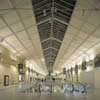
photo : SNCF – AREP / M. Vigneau
To preserve and enhance the original station designed by architects Armand in 1853 and Lisch in 1889, the same materials have been used: glass, for transparency and protection; steel, as a historical expression of the lightness of the structures and a contemporary expression of modernity; and stone, expressing continuity with the city’s 19th and 20th-century buildings. The original stonework has been cleaned.
Gare de Paris Saint-Lazare, en cours d’achèvement de réamènagement – Accès escalier en pierre (mars 2012)
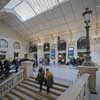
photo : SNCF – AREP / M. Vigneau
Paris Saint-Lazare Train Station images / information from AREP
Location: Paris Saint-Lazare, Paris, France
New Paris Architecture
Contemporary Paris Architecture
Paris Architecture Design – chronological list
Paris Architecture Tours by e-architect
Another Paris Train Station Building on e-architect:
Versailles-Chantier Station
Design: André Ventre
Gare Versailles Chantier
Gare Versailles-Chantier, designed by André Ventre (1874-1951) in the late 20’s and early 30’s, is the largest of Versailles three train stations.
Railway Train Station Buildings in Europe – Selection
Liege-Guillemins Railway Station, Belgium
Santiago Calatrava Architect
TGV Railway Station Belgium
Bruxelles Gare du Midi, Brussels, Belgium
Ateliers Jean Nouvel
Brussels Railway Station Building
Parisian Architecture – Selection
Crèche rue Pierre Budin
Design: ecdm
Crèche rue Pierre Budin Paris
Rue Pajol sports centre
Brisac Gonzalez Architects
Pajol Sports Centre
Eva Samuel architecte urbaniste et associés
Ecole Maternelle Paris
Comments / photos for the Paris Saint-Lazare – French Train Station Building page welcome

